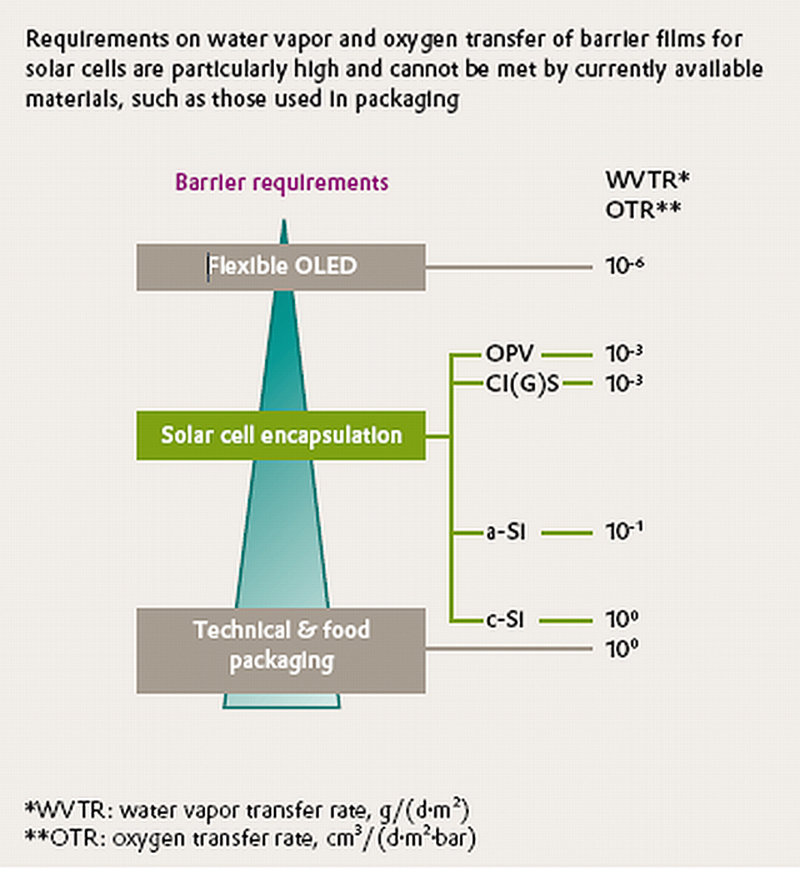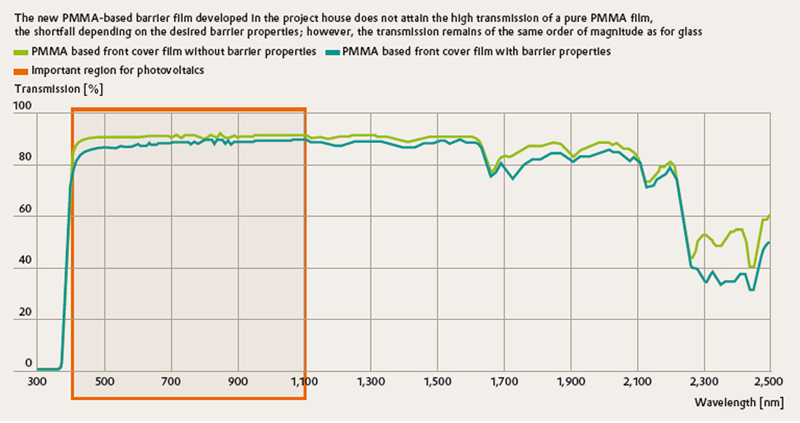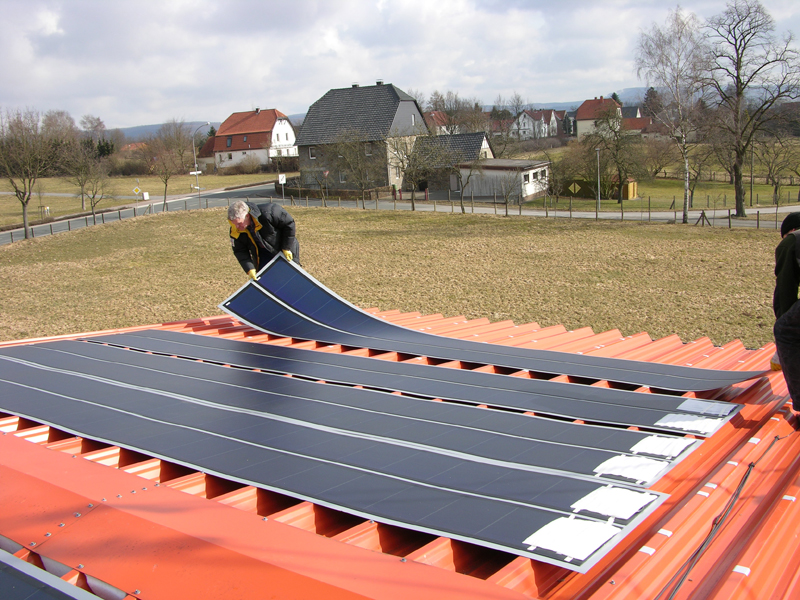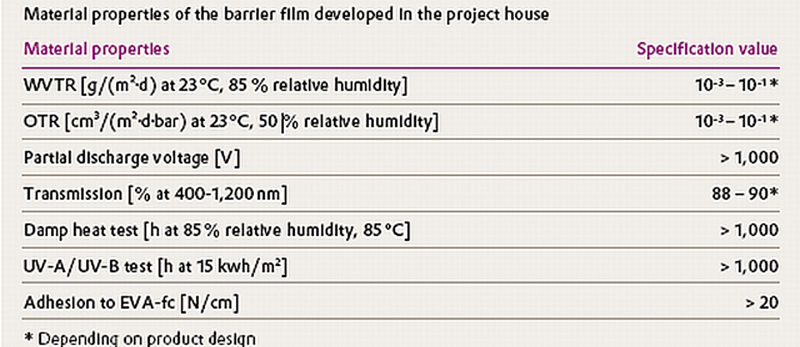Author:
Dr. Florian Schwager, Product Manager, Solar Barrier Films, Performance Polymers, Evonik
Date
03/24/2011
Thin-film solar cells are developing into a rapidly growing market segment. If their commercial potential is to be fully exploited, the solar modules must be produced in a roll-to-roll manufacturing process. Evonik has now developed the "missing link" necessary for continuous production: a highly transparent and also weathering-resistant barrier film based on PLEXIGLAS® that can replace glass plates as a front cover. Flexible copper indium gallium diselenide (CIGS) thin-film solar cells from Solarion AG, headquartered in Leipzig. Established in the year 2000, the company started up in 2002 the first industrial pilot line in Europe for production of high-flexibility ultralight CIGS thin-film solar cells on a polymer substrate. An industrial scale manufacturing plant is currently constructed. CIGS technology achieves higher efficiencies compared with amorphous silicon technology, but requires superior barrier properties in the encapsulating material Most of the solar modules to be found on roofs in Germany today contain crystalline solar cells, for which the light sensitive semiconductor layers are produced from silicon wafers. The technology is now well understood: Modules of crystalline solar cells have lifetimes of 25 to 30 years and attain efficiencies averaging 16%. In these modules the solar cells, which are soldered to one another, are embedded in a thermally curing polymer that protects them from excessive mechanical stress. This is backed by an electrically insulating and weathering-resistant film, and at the front a glass plate shields the cells in the modules from environmental effects. A module of this type, typically measuring 1.5m x 1m, weighs about 20kg. Mono- or polycrystalline solar cells have thicknesses between 150 and 300 micrometers but the upper 10 micrometers absorb the incident light; a better solution is offered by thin-film solar cells, which are about 100 times thinner than the wafer-based cells. These are made from a variety of materials such as amorphous silicon (a-Si), cadmium telluride (CdTe), and copper indium (gallium) selenide/sulfide (CIGS/CIS). At present they attain module efficiencies of only about 11% at most, but they have the advantage that they can be manufactured in a continuous roll-to-roll process that is highly cost efficient compared to crystalline solar cell production, which, in the tradition of the semiconductor industry, is a batch process. If the barrier film protecting the solar cells from environmental effects is of plastic rather than glass, flexible and therefore cost efficient thin-film solar cells can be realized with a number of semiconductor materials. (CSG = cristalline silicon on glass, a-Si = amorphous silicon, ?c-Si = microcristalline silicon, DSSC = dye sensitized solar cell; OPV = organic photovoltaics) But there's one obstacle in thin-film solar cell production: Until now, the producer has had at some stage to convert the continuous process to a batch process because no suitable barrier films are available that protect the solar cells from harmful environmental effects over the long term. This means that, with only a few exceptions, even modules with flexible thin-film solar cells have glass plates on the front, and with glass no continuous production process is possible. While thin-film solar modules in the form of roll material do exist, the ethylene tetrafluoroethylene (ETFE) film used does not provide adequate barrier properties; it allows water vapor and oxygen to pass through largely unhindered, so that corrosion effects reduce the service life of the cell. Given this situation, the industry is interested in a suitable covering film that has the same properties as glass as far as possible and can be integrated into a continuous, and therefore more cost effective, production process. Organic solar cells, which consist of conjugated semiconducting polymers and are currently being intensively investigated, would also benefit from film technology of this kind because they have the additional advantage of being easily printed and can therefore be produced in a roll-to-roll process. At this point, researchers of Evonik�s Functional Films & Surfaces Project House took up the challenge: Why not, they asked, use the Group�s polymer expertise to develop a suitable polymer film? This would have to act as a barrier to water vapor and oxygen, allow high light transmission, adhere well to solar cells, and be electrically insulating, flexible, and cost efficient. It should also have high weathering and UV resistance. In short, this would mean developing an entirely new system solution for the photovoltaics industry. Poly (methyl methacrylate) (PMMA) has many of the required properties such as high transparency, weathering resistance, and UV stability. Initial trials in the project house, which is managed by Evonik's strategic research unit Creavis Technologies & Innovation, were therefore carried out with a film based on PLEXIGLAS® molding compound, which the researchers coated with an inorganic oxide film as a barrier, using a sputter process. The results were disappointing, however: The film could not withstand the sputter process and the barrier requirements could not be met.

Requirements on water vapor and oxygen transfer of barrier films for solar cells are particularly high and cannot be met by currently available materials, such as those used in packaging The new PMMA-based barrier film developed in the project house does not attain the high transmission of a pure PMMA film, the shortfall depending on the desired barrier properties; however, the transmission remains of the same order of magnitude as for glass


Composite film provides required properties Further investigation and tests, for which the project participants also drew inspiration from packaging industry technologies, resulted finally in a multilayer film with the required barrier properties. Water vapor and oxygen permeability— the yardstick for barrier properties—in the thinfilm solar cells need to be one to three orders of magnitude lower than in conventional packaging films. The multilayer film consists of several functional and bonding layers and an outer PMMA layer. The PLEXIGLAS® protects the underlying layers of the film very efficiently against the effects of weathering, thus ensuring the necessary longevity. In the spectral range relevant to photovoltaics, Evonik's new film achieves transmission rates of 88 and 90% in the short-wave and long-wave regions; these figures are comparable to those for glass plates. The film is currently being put through weathering tests at the Fraunhofer Institute for Solar Energy Systems in Freiburg (Germany), which exceed the requirements of the IEC 61646 standard for thin-film solar cells. The tests expose the laminated film to strong temperature fluctuations, UV radiation, high humidity, and mechanical loads such as arise from hail, snow, and wind. It is already clear that the multilayer film will more than satisfy the standard in regard to the damp heat test and UV resistance. The new specialty film is now available off the roll in widths of up to 1.2 meters. The first customers are already testing the film for use in their flexible thin-film solar modules. The project having been successfully wound up in Creavis's Functional Films & Surfaces Project House, its activities are now continued in the Performance Polymers Business Unit.

The TF plate flexible module from Centrosolar AG, Paderborn, is a solar roofing system for large and industrial roofs with a nominal output of 288Wp. The solar power plates are based on thin-film laminates bonded to polymer-coated steel sheeting, and can for example be mounted on trapezoidal sheet metal. The solar roofing system contains thin-film cells with triple-junction technology from United Solar Ovonic, so that excellent yields are obtained even for unfavorable roof alignments or angles. Triple-junction technology is based on amorphous and microcrystalline silicon that is relatively resistant to environmental effects and can therefore be encapsulated with the polymer films currently available on the market. Attractive growth market Thin-film solar cells and modules will soon develop into the fastest growing segment in photovoltaics because of their low weight; they weigh less than a third than crystalline silicon solar modules.